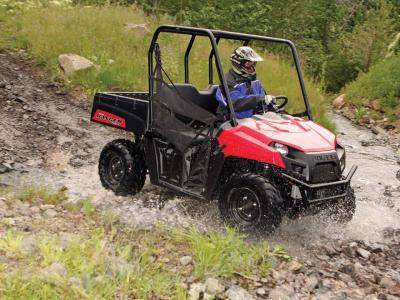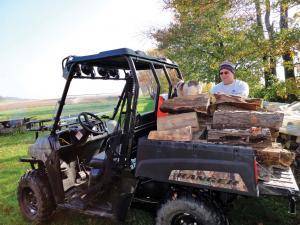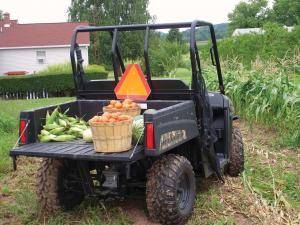
There are companies that have a knack for finding opportunities in the market and then building a product to fill it. The Disney people never build a ride without a movie, toys, and a happy-meal to go with it, and in the powersports world, Polaris has always managed to find that untapped group of potential riders that didn’t quite find what they needed with existing models. Since the Side x Side market is relatively new, it’s been the habit of most manufacturers to concentrate on their top of the line models. Polaris has done that as well, but at the same time they never forgot those left behind. By filling the needs of all types of riders, they’ve quietly become the powerhouse of the power sports world. Think of the multi-passenger RZR4, the first, true sport Side x Side RZR800, the hard working Ranger Crew, and one of their best models, the mid-sized Ranger 500 EFI.

We’ve been using the Ranger 800 XP for a couple years for everything from farm work, to hauling wood, to grounds work on the local little league diamond. Regardless of whether we’re hauling bales or bats, the Ranger 800 XP has been outstanding, always ready for whatever we ask of it. It’s a well-designed, well finished machine with excellent power, comfortable seating for three, plenty of storage, and the ride is the smoothest in the industry. We love it, but not everybody needs or even wants a full sized, high horsepower machine; there-in was the opportunity. Polaris quickly answered the call with the Ranger 400 then followed it up with the Ranger 500 EFI, but rather than being stripped down, junior versions of their top of the line models, both machines come with plenty of the features and capabilities of their bigger brothers.

The Ranger 500 EFI is built on the same sturdy, steel platform as the Ranger 400, which means it is slightly smaller than the full sized Ranger XPs. A 32 horsepower, 498cc liquid cooled, 4-stroke engine fed by Electronic Fuel Injection easily powers the Ranger 500 along, and even with huge elevation changes or steep grades, the engine carried us up and down steep trails with no problem. We were especially glad to have electronic fuel injection which pretty much guarantees easy starts regardless of temperature or elevation, and it’s a feature we normally wouldn’t expect on a value class machine like this. Top speed is 44 mph, which is actually slightly faster than some other manufacturer’s best machines. Regardless of the speed or RPM, though, the engine purrs along quietly. Just like other Ranger models, the engine is mounted under the bench seat. Polaris uses their PVT transmission on the Ranger 500 which features HI, Low, Neutral, Reverse and Park, and most of the time we ran it in High. For any heavy load hauling or steep hills, we shift it into low and it still gets up to speed quickly but with a little more torque and a lot less stress on the belt. The Ranger 500 EFI does offer another unique feature in that it can be equipped with an optional SPEED key which limits top speed to 23 mph. That should keep speed under control with work crews and less experienced riders.

Full sized Ranger models are known for their comfort, and the Ranger 500 EFI does not disappoint in this area. We appreciate how easy it is to get in or out of the Ranger 500, and even though the bench seat is built for two, it is very comfortable. Controls are well placed, the steering wheel is at a good level, leg room is sufficient even for taller riders, and the seat belts don’t dig into your shoulders. Pedal angle on both the brake and throttle seems very good and they provide good feel and feedback to the driver without any jerky, lurching caused by incorrect throttle angle. On the dash is the gear shift lever, a closed dash box, two open storage areas, the 2wd/4wd switch, lights, and a center mounted instrument cluster that includes an odometer, fuel level indicator, and speedometer. There is even a pair of cup holders! One unfortunate thing we’ve managed to do on three different Polaris models is put a small crack in the floorboard. It happens during ordinary trail use when a thick stick flies up from the front tire and jams into the floorboard. It’s probably just a fluke, but we wanted to let you know. The most important feature on the Ranger 500 EFI is the Certified Roll-Over Protective Structure (ROPS). We’ve never had one upside down to test it, but it’s nice to know it’s there.

When the going gets tough, the Ranger 500 offers the Polaris On-Demand 4 wheel drive system which is easily engaged with a flip of the dash mounted switch. Normally we ran the Ranger in 2wd but it also features the VERSATRAC TURF MODE which unlocks the rear differential for easier, tighter turns that won’t tear up your grass. We definitely appreciated the 10 inches of ground clearance which helps you clear trail obstacles as well. In whatever mode you choose, though, the suspension easily handles rock and stream crossings, rutted trails, and mud. About the only thing we would change would be the steel wheels which we’ve managed to bend lately. A nice, cast aluminum, aftermarket wheel would provide extra insurance, especially on long rides back to the deer camp or far from the truck or cabin where you don’t need any trouble.
February 13, 2023
3wheels@mail2tor.com
since@ 2012 -2024
3wheels@mail2tor.com